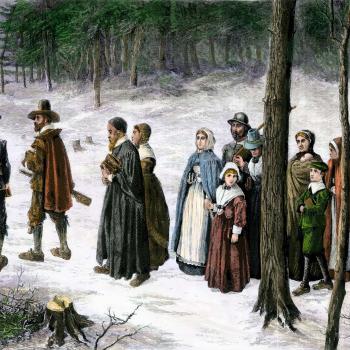I recently listened to a very interesting Rough Translation episode on American evangelicals’ approach to caring for the environment. In a nutshell, there have been moments in the past when evangelicals seemed like they could get on board with combatting climate change, but each time, these moments have fallen through. There is an argument made in the podcast that evangelicals’ theology follows their position on climate change, rather than the other way around, and that their position on climate change tends to be more shaped by political factors (aka the Republican Party).
While I find this argument plausible, I would want to do some more research and reading before being certain of it. The simple reality is that there are some aspects of evangelicalism—and particularly more fundamentalist or young earth creationist evangelicalism—that do seem to prime individuals to be less concerned about climate change than otherwise.
First and foremost, of course, is the belief that the earth will soon be destroyed by fire, a la the rapture and tribulation. I spent my evangelical childhood worried that the rapture would happen before I had time to grow up, get married, and have sex children. And I only worried about this because the evangelical adults around me told me that it was completely possible (nay, likely) that exactly this would happen. If you genuinely think the world is going to come to a fiery end sometime in the next decade or two anyway, why care at all about climate change?
Second, though, is the belief that the earth has already undergone absolutely enormous climate change in the past few thousand years and everything has been fine. And no, I’m not just talking about the little ice age five hundred years ago, although that does get brought into the conversation. I’m talking about Noah’s flood.
Here is how Ken Ham put it on the Answers in Genesis website last week:
[T]here’s been climate change in the past. Of course, the biggest climate change was the global flood of Noah’s day about 4,350 years ago. This flood destroyed the world that then was and upset the climate, including creating the perfect conditions for an ice age following the flood. The world has been settling down since that flood.
Remember, according to Answers in Genesis, Noah’s flood began with a massive meteor storm that fractured the earth’s crust (we’re talking about dozens of meteor strikes on the magnitude of the one that killed the dinosaurs). During the flood, the earth’s plates sped away from each other, as continents moved from one landmass to their current positions at a speed that would have vaporized the oceans (I suppose that’s where all the rain came from). At the same time, there was massive volcanic activity as volcanoes on the scale of Yellowstone erupted all over the world.
There is literally no way life could have survived Noah’s flood, as Answers in Genesis describes it. Their model combines the most catastrophic events in earth’s history, grossly accelerates them, and places them all in the span of one year. And yet somehow, this utterly catastrophic sequence of events destroyed neither life (aka those on the ark) nor the climate.
Is it any wonder they see a few degrees of climate change and a few feet of rising sea levels as so mundane? How do you communicate to someone who thinks ecosystems are so resilient that you can literally destroy the earth and everything will be totally fine afterwards that ecosystems do not work like that?
Ham would probably say that I’m being disingenuous by leaving out the demise of the dinosaurs. So let me talk about that! Answers in Genesis holds that extinct species such as the dinosaurs are examples of creatures whose ecosystems were destroyed by the flood and never returned. In other words, the massive catastrophic events of the flood did create lead to the destruction of some ecosystems and cause the extinction of some species—most notably the dinosaurs, but also others. Therefore, their models do take the impact of climate disruptions seriously. Except for the part where nothing would have survived the continents ripping across the globe at breakneck speed. And you know, all the other things.
The key point I want to make here is this—if a person really believes you could have climate disruptions on the scale of a global flood plus massive meteors plus extreme volcanic activity plus enormous plate tectonic activity all at once, along with massive species extinctions, and still have everything be completely fine for human habitation afterwards, is it really all that surprising that they aren’t particularly worried about a slight rise in global temperatures and sea levels?
I mean, if the earth really is that resilient, this is nothing.
With all of that out of the way, I want to add one thing, merely to highlight how disingenuous Answers in Genesis is being here. These paragraphs come immediately after the one I quoted above:
[E]ven since the flood, we’ve seen other climate change events. There was a warming period during the Middle Ages that allowed farmers to settle and grow crops on Greenland—not something I suggest doing today! There was also a Little Ice Age in the 16th century that impacted agriculture significantly. And no one was driving cars, flying airplanes, or building factories back then!
Clearly, there’s more to climate and the changes we’re currently seeing than just an increase in carbon dioxide, as we’re so often told by the alarmist media.
Why is this disingenuous? Well, several days before this piece was published on the Answers in Genesis website, a trio of studies was published finding that current climate change is in a completely different category from climate events we’ve seen in the past 2,000 years, including the warming period and little ice age mentioned by Ham.
“Although the Little Ice Age was the coldest epoch of the past millennium, the timing of the lowest temperatures varied from place to place,” St. George wrote. “Two-fifths of the planet were subjected to the coldest weather during the mid-nineteenth century, but the deepest chill occurred several centuries earlier in other regions. And even at the height of the Medieval Climate Anomaly, only 40% of Earth”s surface reached peak temperatures at the same time. Using the same metrics, global warming today is unparalleled: for 98% of the planet’s surface, the warmest period of the Common Era occurred in the late twentieth century.”
In other words, in the past, climate events have been variable and regional, shifting and different from place to place. Not so now. This means that what we’re seeing now is something completely different from other climate events in the recent past. And yet, despite the fact that all of this was out there and already being talked about in the news, Ham doesn’t even mention it. He ignores it, and simply asserts that these weather events were essentially the same as what we’re seeing now.
The Rough Translation episode on evangelicals and climate change that got me thinking about all of this again did point to one specific role young earth creationism has played in fueling evangelical disbelief of climate change—namely, the claim that scientists are engaged in a massive scientific fraud vis a vis evolution has rendered evangelicals unwilling to believe what scientists say about climate change. Yet, as we can see in Ken Ham’s assertions regarding climate and the flood, this isn’t the only role evangelical adherence to creationism has played in evangelical skepticism of climate change.
To quote blogger Hemant Mehta regarding Ken Ham:
Good god, the man’s ignorance is going to destroy our entire species.
While there are many other forces at play in climate change denial and foot tragging—capitalism and companies’ profit motives chief among them—Mehta isn’t entirely wrong.
I have a Patreon! Please support my writing!















